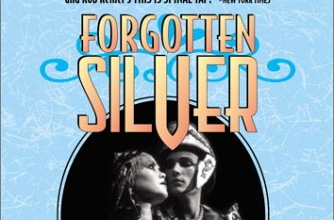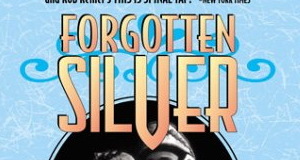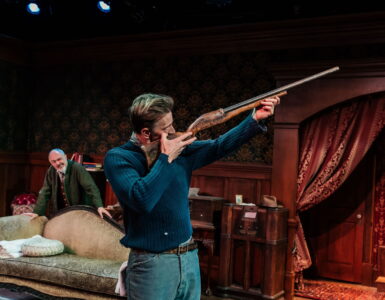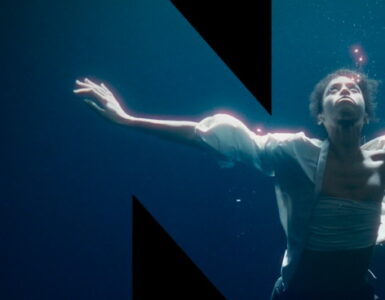
Forgotten Silver is quite an elaborate ‘mocumentary’ – how did it all come about?
Director Peter Jackson — “It was kind of a joke, really. It was one of those fun type of movies to make, that you’re not really doing it for any serious reason other than you were lucky enough to be given some money to have a good time and stage this elaborate prank. The basis of the idea was a little newspaper story that I read in a New Zealand newspaper, maybe six or seven years ago, concerning a group of film historians or archaelogists in California who had gone out into the desert somewhere and had scraped away the sand and uncovered one of Cecil B. de Mille’s sets from the 1920s, just made of wood and plaster but effectively revealed this Biblical city in the desert. So just that idea, transposed to a New Zealand setting, was the attraction and the whole part of getting Forgotten Silver together.”
What about the films of Colin McKenzie — were they films that you fooled around with and made youself?
“I worked with a co-writer and co-director, Costa Botes, and once we had the initial idea we developed it into a more elaborate story that chronicled this guy’s life. So, as part of the twist in the story, we uncover a whole cache of his early films that have been forgotten so we had to recreate the films, yeah.
Where did the sets come from that we see in the film?
They were sets that we built and sometimes we used a little bit of computer trickery to make things look a little bigger.
So the funding was to make all the elements of the documentary from scratch. You didn’t have the films to start with?
No, the money was for the whole thing. Apart from a few existing documentary clips of Stalin and a couple of other bits and pieces, everything we used was shot for the movie.
I believe Forgotten Silver was aired on television in New Zealand first. How was it received?
Most of the people that saw it seemed to actually fall for it, which surprised us in a way. We didn’t intend that. The publicity before the screening made it sound like a true programme. We deliberately didn’t want to give the game away but we were quite sure that there’s enough silly stuff in there and enough over the top humour that at some stage during the course of the film people are going to start to twig to the fact that it’s not real. But it did actually surprise us how many people in New Zealand actually fell for it.
Why do you think that is?
I just think people want to believe in heroes. They push all the unrealistic, over-the-top stuff out of the back of their mind in a desperate need to believe that this is actually true. It’s very sweet, really.
When do most people cotton on, though?
I don’t know. I think everybody’s different and I haven’t seen it enough times with an audience to actually know. I guess different people cotton on at different times, depending on how sharp you are.
There is not really a tradition of this kind of film, of a deceptive, phoney documentary. There’s Zelig — were you at all inspired by Woody Allen’s film?
Not really, no. That wasn’t the reason for doing it although once we were doing it we were wanting to achieve the same kind of seamless, cinematic tricks that that film contained.
But with less computer trickery, perhaps?
We used computers for a few shots. But we were very much aware that we wanted the film to be more than just a one joke movie. It also has to stay entertaining for people who know the joke. There’s no point spending all this effort and making this film if as soon as people know the joke it becomes a pointless exercise screening it. The film has to operate on some level of drama beyond the fact that it’s a pseudo documentary. We actually took quite a bit of care in trying to make his story as dramatic as possible and as entertaining as possible so that even if you know it’s not true, it actually doesn’t destroy your entertainment of the film.
How did you put the so-called early films together and techniques did you use?
You just had to work backwards from where we are today. It’s one of those areas where technology is frustrating because we didn’t use any old cameras or anything, we used completely modern cameras so everything is rock steady and perfectly sharp and the technology today operates in exactly the opposite way to what they were used to so it was just a case of deteriorating the film and copying it and deteriorating it again. We used chemicals to stain it and we scratched it. We dragged it across the floor and through sandpaper and made it unsteady in the camera and played around with fluctuating the exposure all the time during the shots. We just studied old movies and looked closely at what they looked like. People often try this and they think so long as it’s black and white and it has some scratches down it that it looks like old film but old film has a lot more subtleties, such as the size of the grain and the contrast ranges that it picks up. We were very careful to go into a lot of detail to try to make our stuff look as realistic as possible.
But not to the extent of mixing egg whites to make your own emulsion, much like Colin McKenzie allegedly did.
No, no — we didn’t use any of his techniques.
What about the casting? You’ve got some people there who really look as if they were around in the early part of the century. It’s really quite seductive, this deception.
You’ve just gotta be careful. Casting is very important and you can’t just grab your friends and stick them in front of the camera. You’ve got to look for the right faces and there are some faces that look as if they belong in the 1920s more so than some others. We looked at hundreds of photos from the different agencies until we found the right ones. This one case when acting skill wasn’t the primary factor.
You say some people were duped in New Zealand. Isn’t it possible that in time more people will look at your film as an historical account rather than a joke? Do you have any moral obligations here at all?
No. I think that as time goes on the fact that it’s a joke will become more and more well known, so I think it’s the reverse of that, really.
The budget was around $600 000 and as for the shoot, I shot all the recreated stuff and that was about two weeks worth of shooting. We did it very quickly. Then I handed it over to Costa who shot all the documentary stuff and I’m not sure how long he took. It was all happening just before The Frighteners started. I would check in with him from time to time to see how he was putting it all together and maintaining some sort of input at the weekends while The Frighteners was underway, so it was a bit full-on for me doing two movies at once.
This is pretty much a shoe-string event, isn’t it, you’ve really done it as cheaply as possible, is that right?
We got the amount of money that we needed to make it, but yeah it was pretty tight.
How long was the pre-production?
I can’t remember now – usual time – it’s all a bit blurry.
It’s really cheeky that you’ve got Leonard Maltin and Harvey Weinstein endorsing your deception — were there limits? How far were you prepared to go with this deception?
You go as far as you need to in order to make it real. We were very lucky that those guys agreed to do it. They both saw the humour in it and realised it was a bit of fun. You have to take this all with a sense of humour and have some fun with it. It certainly makes a change from all the usual straight movies that we all the time.
Was there a backlash at all, from those who were duped?
People either laughed at it when they found out or they got angry, depending on how stupid they looked. Some people were angry but that doesn’t matter. Don’t take it too seriously. Loosen up a bit. People have to realise that just because they see something on film, in a documentary format that it doesn’t necessary have to be real.
It’s funny that you’ve taken so long to make that point.
It just shows you how easy it is to fool a lot of people with something that is incredibly over the top and unrealistic. The intention wasn’t to make people feel stupid, it was for us to have some fun and create a documentary about someone’s life, complete with archival material. There are no rules that say that person had to actually exist.
But you’re not going to change the way you promote the movie?
That’s all out of my hands. I have no idea what’s going to happen. If people can still perpetuate the myth for a while then it makes it more fun. It would be a shame if every time it was screen it had advance publicity that it was fake.
It’s not as if it makes everyone run into the streets and panic, like Orson Welles’ War Of The Worlds.
No one gets hurt. It’s a harmless thing.
Is this a perverse side of your nature?
It’s just a gentle harmless prank.








